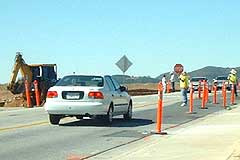It’s spring, so cone zones and diamond-shaped "Road Work Ahead" signs are sprouting up on highways across the U.S. For those who travel the highways, there are really two seasons - Winter and Construction. The American Trucking Associations offers some tips on coping with highway construction work zones with less frustration, and most importantly, safely.

Double the usual following distance behind other vehicles in construction zones. This will give you the needed time to time to safely react to warnings or hazards, like debris or potholes that suddenly pop out from under the vehicle ahead. If you cannot avoid potholes or debris, stop and inspect your vehicle, especially the tires and wheels, for damage at the first opportunity.
Pay close attention to operating construction equipment while in a work zone. Watch out for equipment pulling or backing into your path. Keep an eye out for construction workers. If you are driving a wide vehicle like an RV, make sure you are not going to tangle with protruding construction equipment or scrape those concrete road dividing barriers.
Watch out for “zippers”, those discourteous drivers who wait until the last chance to merge into the available lanes around work zones. The name comes from the way these unsafe motorists zip in and out of slowing traffic, endangering other motorists who are obeying the work zone signs. This type of behavior in a cramped construction site endangers not only drivers, but highway workers as well. And don’t be a zipper yourself by getting into the correct lane well in advance.
Remember that most work zone traffic lanes are narrow and don't have shoulders or emergency lanes due to the use of those orange barrels and constricting rows of concrete walls. When a temporary median crossover is used, beware that uneven or sloped road surfaces can dramatically affect handling and stability of vehicles.
If you encounter a particularly heavy traffic congestion and “Expect Delays” sign occurs. Pull over and wait before entering a construction zone. Talk a walk or nap, have lunch, or just enjoy the scenery. If you are Internet savvy, you can surf over to the website that many state DOTs have that provide information on major road construction projects. Use this information when planning your route.
Obey speed limits even more carefully in construction zones. The police really do enforce the “double fines in contruction zones” traffic laws.
Finally, report absence of signs, or poor signage, to the appropriate highway department. To the extent possible, work zone signage should tell drivers what is going on and what is expected of them. This adds credibility to the warnings, hopefully leading drivers to believe -- and obey - the signs. Construction crews should alert drivers to a work zone at least two or three miles before they begin. This prevents many last-minute merger problems and allows drivers enough time to get into proper lanes at proper speeds.




